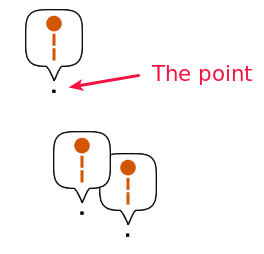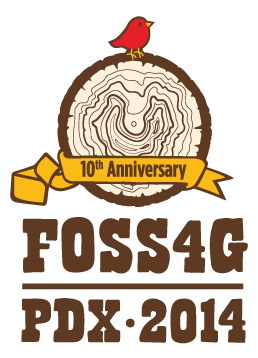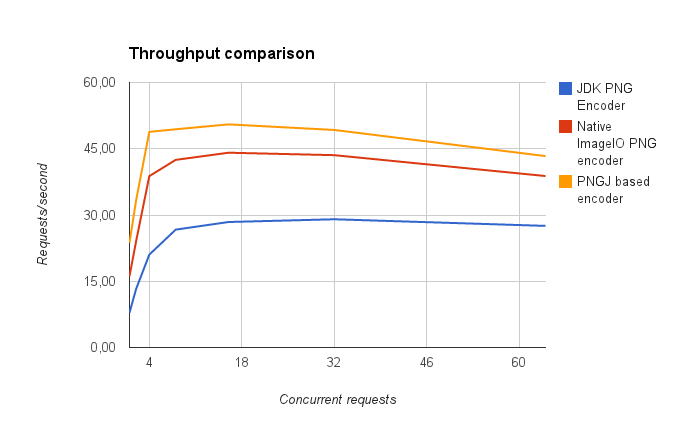GeoServer Blog
FOSS4G 2014 Save the Date
Get your hack on the map this year at FOSS4G 2014. The event runs from Sept 8th-12th in sunny* Portland Oregon. The conference is an amazing creative gathering of everything that makes open source and mapping fun. It would be great to see you there.
Last year we had a great selection of GeoServer presentations. If you are interested in presenting please keep the April 15th submission deadline in mind.
* In traditional west coast fashion Sun may be replaced with large cups of coffee
GeoServer Sprint Sunday Sep 14
Have you booked your flight yet? Please consider staying an extra day to enjoy the company of the geoserver-devel team on Sunday Sep 14.
The GeoServer team is looking at extended the FOSS4G code sprint by an extra day in order to get some face-2-face work done. There will be a few teams attending remotely (hi CSIRO!) so if you are unable to extend your air fair you may still be able to take part.
We would like to thank Mike Pumphrey (Boundless) for arranging a venue. We are seeking additional sponsors to cover food and activities. Please contact Jody Garnett if you are in position to help out.
GeoServer 2.5-RC2 released
The GeoServer team is happy to announce the release of GeoServer 2.5-RC2. Download bundles are provided (zip, war, dmg and exe) along with documentation and extensions. Currently we are awaiting compilation of the Mac artifacts.
GeoServer 2.5 is shaping up to be a great milestone and we would like to thank all those who have downloaded 2.5-RC1 and submitted feedback and pull requests.
-
The Oracle JNDI store now exposes fetch sizes,
-
CSW requests are namespace aware again and
-
Improved handling of unknown elements in configurations which should aid downgrading installs by Andrea Aime
-
Polar Stereographic projections have been fixed by Ben Caradoc-Davies
-
Further thanks to Andrea for reviewing and merging pull requests
-
Thanks to Ian Turton, Envitia and the Scottish Government’s AFRC for facilitating this release.
-
Check the release notes for more details
-
This release is made in conjunction with GeoTools 11-RC.
With all this help GeoServer 2.5 is on track for release in March. We would like to encourage you to download the release candidate and test with your data. This will both help you avoid any surprises, and assist the team in bringing you the best possible GeoServer.
About GeoServer 2.5
Articles and resources for GeoServer 2.5 series:
-
GeoServer 2.5-beta announcement reviews key features of this release:
-
WCS 2.0 and WCS 2.0 Earth Observation have been added (thanks to DLR and Eumesat for funding this)
-
The addition of a batch importer to making setting up GeoServer easier (thanks to MapStory).
-
High performance PNG encoder based on PNGJ library (Andrea Aime). Improved JPEG performance using libjpegturbo available as an optional extension (Simone Giannecchini and Daniele Romagnoli)
-
Use of ST_Simplify to improve PostGIS rendering performance (a collaboration with Andrea and Jonathan Moules).
-
New implementation of GetFeatureInfo that takes into account symbol shapes, offsets, and dynamic line widths into account (thanks to Eskilstuna municipality for funding this).
-
-
Using GeoServer at IGN to create new digital maps is an impressive look at advanced styling deployed by the french mapping agency
-
Labelling a MultiPoint geometry with WPS (Boundless) is a good example of integrating WPS and Styling
-
Achieving extreme GeoServer Scalability with new Marlin vector rasterizer (GeoSolutions) shows an exciting JRE extension that can be used for improved performance. If you are using GeoServer with a large number of CPU cores you owe yourself an hour to try this out.
-
DXF output format promoted to official extension for GeoServer (GeoSolutions)
-
Active Directory based security in GeoServer through LDAP (GeoSolutions)
Extended Release Schedule
The GeoServer release schedule been extended with a six month maintenance phase. This change will result in less frequent releases of GeoServer, for a longer period of time.
The updated schedule for the GeoServer is 2.4 series is:
-
GeoServer 2.4.5 March 2014 (Stable)
-
GeoServer 2.4.6 April 2014 (Maintenance)
-
GeoServer 2.4.7 June 2014
-
GeoServer 2.4.8 August 2014
For more information please see the change proposal GSIP 107 - Extended Release Schedule.
GeoServer 2.5-RC1 Released
The GeoServer team is happy to announce the release of GeoServer 2.5-RC1. Download bundles are provided (zip, war, dmg and exe) along with documentation and extensions.
GeoServer 2.5 is shaping up to be a great milestone and we would like to thank all those who have downloaded 2.5-beta and submitted feedback and pull requests.
-
A couple map rendering issues have been fixed with better white space handling for CSS labels and crisp SVG symbols rendering.
-
Konstantin Surzhin has provided many small user interface fixes
-
Mauro Bartolomeoli has been untangling a conflict between the css extension and the printing modules.
-
Thanks to Andrea for his hard work, and constant review of pull requests.
-
Thanks to Jody Garnett and Boundless facilitating this weeks release.
-
Check the release notes for more details
-
This release is made in conjunction with GeoTools 11-RC1.
With all this help GeoServer 2.5 is on track for release in March. We would like to encourage you to download the release candidate and test with your data. This will both help you avoid any surprises, and assist the team in bringing you the best possible GeoServer.
About GeoServer 2.5
Articles and resources for GeoServer 2.5 series:
-
GeoServer 2.5-beta announcement reviews key features of this release:
-
WCS 2.0 and WCS 2.0 Earth Observation have been added (thanks to DLR and Eumesat for funding this)
-
The addition of a batch importer to making setting up GeoServer easier (thanks to MapStory).
-
High performance PNG encoder based on PNGJ library (Andrea Aime). Improved JPEG performance using libjpegturbo available as an optional extension (Simone Giannecchini and Daniele Romagnoli)
-
Use of ST_Simplify to improve PostGIS rendering performance (a collaboration with Andrea and Jonathan Moules).
-
New implementation of GetFeatureInfo that takes into account symbol shapes, offsets, and dynamic line widths into account (thanks to Eskilstuna municipality for funding this).
-
-
Using GeoServer at IGN to create new digital maps is an impressive look at advanced styling deployed by the french mapping agency
-
Labelling a MultiPoint geometry with WPS (Boundless) is a good example of integrating WPS and Styling
-
Achieving extreme GeoServer Scalability with new Marlin vector rasterizer (GeoSolutions) shows an exciting JRE extension that can be used for improved performance. If you are using GeoServer with a large number of CPU cores you owe yourself an hour to try this out.
-
DXF output format promoted to official extension for GeoServer (GeoSolutions)
-
Active Directory based security in GeoServer through LDAP (GeoSolutions)
GeoServer 2.5-beta released
GeoServer team is pleased to announce the release of GeoServer 2.5-beta.
This release is packed with new features and interesting new extensions. Here is some reason why you should try 2.5.-beta.
WCS 2.0 and WCS 2.0 EO
GeoServer 2.5 is now shipping with WCS 2.0 as a core module, a major improvement in terms of usability compared to both WCS 1.0 and WCS 1.1. For example, getting back the full raster is now as easy as:
http://localhost:8080/geoserver/wcs?request=GetCoverage&service=WCS&version=2.0.1&coverageId=nurc__Img_Sample
while getting the same, but with half the size, can be achieved using:
http://localhost:8080/geoserver/wcs?request=GetCoverage&service=WCS&version=2.0.1&coverageId=nurc__Img_Sample&scaleFactor=0.5
Paired with the WCS 2.0 module we have the WCS 2.0 Earth Observation (EO) extension, which adds the ability to expose the time dimension using standard extensions to the base WCS 2.0 protocol. We’d like to thank DLR and EUMESAT for sponsoring this work, and GeoSolutions for carrying it out on their behalf.
Batch layer importer extension
A new extension that allows for batch import of data, dubbed “the importer”, is now also available. It supplements the existing GeoServer ui by adding a much more convenient workflow for layer configuration. For example previously configuring multiple Shapefiles (or multiple PostGIS tables) required users to tediously configure one by one. With the importer it can achieved with a few easy to follow steps. The importer is accessible from both the web ui and a REST api, making it easy to use in a variety of environments.
The importer also allows for consumption of formats that GeoServer does not support natively. Formats such as KML and CSV can be conveniently ingested into an existing data formats such as PostGIS and be efficiently served.
The importer was developed and contributed by Boundless. A special thanks to them and the MapStory project for providing most of the funding and requirements for the extension.
WMS performance and quality improvements
Going back to pre-existing protocols, let’s have a look at WMS.
A new higher performance PNG encoder has been included in GeoServer. Based on the open source PNGJ library, and with special local optimizations to extract pixels for encoding with minimal overhead, the encoder provides a significant speedup over the encoder included in the JDK (that is, the one you get by default) and also over the ImageIO native extensions one (which is available on selected platforms, and requires you a separate installation). Here are some results comparing map thoughput using the FOSS4G WMS shootout test harness, using Oracle JDK, and then OpenJDK:
GetMap thoughput over Oracle JDK 7
GetMap thoughput over OpenJDK7
Before you get overly excited, remember that this speedups were achieved because the PNG encoding had a major effect on this benchmark, which was drawing maps with rather light contents, if you have maps that take more than 200ms to be rendered the improvement will be difficult to notice by the naked eye (these chart show throughput, to have a reference, the slowest single threaded result in terms of response time was 120ms, for the JDK encoder based results). The work on this topic was done by Andrea Aime in his spare time, but let’s not forget to thank Hernan J. Gonzalez for the all work put in the PNGJ library.
Speaking of performance, if you are building maps with complex geometries on top of a PostGIS database you’ll be happy to hear that we’re now calling ST_Simplify to get the geometries be simplified directly in the database, significantly reducing the time spent to transfer them. A benchmark drawing a large number (a few tens of thousands) of complex polygons in a small scale map went up from 7 r/s (requests per second) to 11 r/s (and yes, we made tests showing we are not slowing down when working on simpler geometries). Thanks to Andrea Aime for working on this, and Jonathan Moules for providing the data, styles and benchmark setup that led to this improvement.
And if you’re interested in JPEG performance instead, just go and install the newly released JPEG Turbo extension, which allows GeoServer to leverage the excellent work done by the libjpegturbo team to speed up JPEG encoding. Here is a benchmark Simone performed on a Windows 64 laptop using a well optimized image mosaic as the source (which notably cannot use the ImageIO native extensions to speed up image encoding):
Changing gear, you’ll also be pleased to hear that point symbols are now rendered with higher quality and all at the same size/appearance, thanks to pixel precise casting of their position, and that we’re suffering from reduced issues at tile borders, even if you don’t manually specify a “border”/”gutter” parameter thanks to a much improved estimation of the symbols size (which is performed using static analyisis of the SLD).
Improved GetFeatureInfo precision
Most WMS servers available today, including GeoServer 2.4 and earlier, have a pretty simple mechanism to find out what you have clicked on a map:
-
decide on a search area, based either on a static configuration, or the size of the biggest symbol in the map being clicked
-
do a BBOX search on the data
This is fine and works well if your maps is made of regular symbols, that is, square enough, and more or less having a similar size. But what happens if your map looks like this, what will you get when you click outside of the small circle, or inside the large one? The two “clicks” onthe map below are at the same distance from the center point of the circles, but one of the two will not work as it should, either you get a positive response from both of them, or no response, whilst you should get a response only with the large circle click.
The same goes if you are using irregular point symbols, or if you are using geometry transformations to offset them from the central point location, GetFeautureInfo might not respond as you like when clicking inside the symbol, because it’s too far away from the actual geometry.

The problem in the end is pretty simple, the commonly used algorithm does not paint the map, so it cannot know how big the symbols will be in the particular area you clicked, nor be informed about their shape. That’s what GeoServer 2.5 does instead, it figures out how much of the map it has to paint investigating the largest symbol in the map, and then actually paints it, quickly, to figure out what was actually available in the point you clicked: this way, you’ll get only what you actually clicked (well, almost, there is still a small 3px tolerance, so if you click just outside of a circle, you’ll get back the info about that circle anyways).
We’re pretty excited about this new functionality, and believe you should be too. Let us know how it works on your maps.
Big thanks to the Eskilstuna municipality for funding the improvement, and GeoSolutions for carrying out the work.
DXF extension
Have a user base that loves CAD tools? This output format is for you then, it adds DXF output for WFS requests, and also for WPS ones, allowing vector data downloads in this common format. Special thanks to Mauro Bartolomeoli for the initial implementation, and for pushing the module up in supported land.
And more
The release packs also a hefty number of fixes and improvements that were not backported to the stable series yet, check out the full release logs for details.
Let us know how it goes
This is the beta release for the 2.5 series, and this is where the user community has the best occasion of influencing the 2.5 release by reporting all issues you find in the release. So please, go download the release, try it out, report issues, and help us create, next month, a very good release candidate






